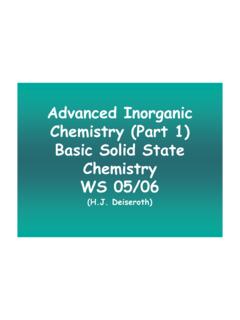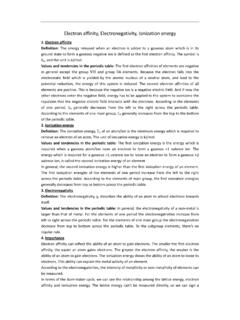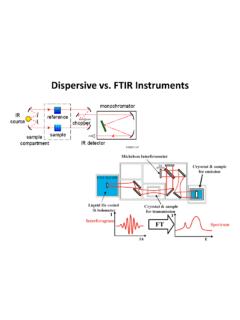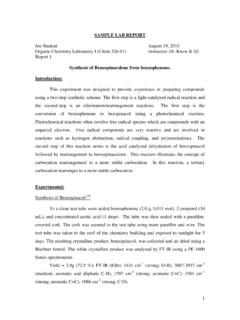Transcription of Vibrational spectroscopy Vibrational Spectroscopy (IR, Raman)
1 11 Vibrational Spectroscopy (IR, Raman) Vibrational spectroscopyVibrational Spectroscopy is an energy sensitive method. It is based on periodic changes of dipolmoments (IR) or polarizabilities (Raman) caused by molecular vibrations of molecules or groups of atoms and the combined discrete energy transitions and changes of frequen- cies during absorption (IR) or scattering (Raman) of electromag- netic radiation of wavelengths from 1 to 300 m (selection rules).One can get/detect: the presence of known compounds (finger print) the components of an unknown compound (functional groups) and thus a likely structure of a compound changes in the concentration of a species during a reaction the properties of bonds (bond strength, force constants) state and order parameters of phase transitions22 Vibrational Spectroscopy (IR, Raman)
2 Vibrational spectroscopyIn order to describe the 3N-6 or 3N-5 different possibilities how non-linear and linear molecules containing N atoms can vibrate, the models of the harmonic and anharmonic oscillators are modes of vibration (normal modes) give rise to absorption bands (IR) if the sample is irradiated with polychromatic light of suitable wavelengths upon changes of the dipole moment = E + E2 + .. scattered light (Raman) if the sample is irradiated with monochromatic light of a suitable wavelength upon changes of the polarizabilities with characteristic energies/frequencies/wavenumbers, intensities and Fwhm s to be determined and frequencies are in the range of 1012 to 3 1014 Hz with Vibrational energies from to 120 kJ/mole (4 10-3 - eV)
3 , wavenumbers from 33 to 104 cm-1, and wavelenghts from 300 to 1 intensities are proportional to the square of the changes of the dipole moments and SpectroscopyWavelengths and energies in Vibrational spectroscopyWavenumber reciprocal of : 1/ (cm-1)Wavelength in nmVis, IR, and Raman areas drawnin a scale of linear wavenumbers and some lasers sources44 Vibrational Spectroscopy - the main principleVibrational SpectroscopyHClr0 Center of mass is not allowedoo shift during the vibrationExtension from r0 (equilibrium distance)Absorption of energy ERelaxation to r0 VibrationTogether with molecular vibrations also molecular rotations are excitedas well since rotational energies are much smaller (~ Evib.)
4 !Hooke s lawF = - k xV = -F dx = kxdxV = k x2 Spring with rate/spring constant kk55 Harmonic Vibrational levelsWarning: Molecular vibrations are essentially anharmonic! Vibrational SpectroscopyZero-point vibration Zero-opint energy E0 Potential curveV = /~~k= Wavenumberk = rate/force constant = reduced mass ~2121mmmm+= F = - k xV = -F dx = kxdxV = k x2 Harmonic Oszillator F = -kx = m b = m d2x/dt2 0 = (1/2 ) (k/m)1/266 Vibrational energy levels in harmonic/anharmonic approximationPotential curve of the harmonic oscillator(En : Vibrational levels, E0 : Zero-point energy) n = 1 Vibrational SpectroscopyPotential curve of the anharmonic oscillator(E0.)
5 Zero-point energy, ED : Dissociation energy)EVIB = h osc (n + ) - h2 2/(4ED ) (n + )2 ( n = 1, 2, ..)For anharmonic vibrations the distances of neighboring Vibrational levels decrease with increasing n (the thickness of the arrows stand for the transition probabilities and in- tensities respectively).condition for IR d 0, condition for Raman: d 0 Selection rules!77 Vibrational states and frequenciesVibrational coupling in zig-zag chains of different lengthsExcitation of a Vibrational state in the electronic ground state S0 by a: infrared absorption, b: Raman scattering, c: inelastic neutron scattering, d.
6 Of frequencies in case of a free molecule (a), static (b) and dynamical (c) coupling in a crystal lattice, and dependence on the wave vector k for all unit cellsVibrational Spectroscopy88 Vibrational SpectroscopyNormal modesEach atom of a molecule (structure) has three degrees of freedom (dof) with respect to displacements, resulting in 3N dof for N atoms. Substracting the dof for translations (3) and rotations (3 or 2), 3N-6 and 3N-5 degrees of freedom are expected for non-linear and linear N-atomic molecules, corresponding vibrations are called normal modes.
7 It is valid that:1. All atoms of a molecule move with the same frequency and in phase, and they move simultaneously through the points of maximum elongation and equilib- rium displacement r0 while the mass center remains amplitudes of the different particles can be The normal vibrations (typically) do not interfere with each other (orthogonality principle). number of normal vibrations ( Vibrational degree of freedom) is3N-6 for non-linear molecules3N-5 for linear molecules99 Vibrational SpectroscopyNormal modesEvery Vibrational mode exhibits its own pattern (vector, matrix) for the atomic displacements ( x, y, y), leading to normal coordinates, but the Vibrational modes are usually not known:Assignment of the Vibrational modes via symmetry properties of the molecules (point group, irreducible representation, character, character tables).
8 Symmetry of vibrations (symmetry species = Rassen, types of vibration) Symmetry species (Rassen) of the modes are denoted after Mulliken:A = symmetric, B = antisymmetric with respect to Cn ; E, F, G, H = 2-, 3-, 4-, 5-fold degenerate with respect to Cn ;g = symmetric with respect to i (from German gerade);u = antisymmetric with respect to i (from German ungerade); Index subscripts of A or B: 1 = symmetric, 2 = antisymmetric with respect to Cn or Sn (a mirror plane);Example: A2g is a vibration that is symmetric with respect to Cn and i (character = 1) and antisymmetric with respect to Sn or (character = -1).
9 1010C3vE2C33 vA1111zx2+y2, z2A211-1 RzE2-10(x,y) (Rx ,Ry )(x2-y2, xy) (xz, yz)Point groupSymbolSymmetry operationsActive vibrations inSymmetry species (Rassen)Group charactersCombinations of the symbols x, y, z, Rx, Ry and Rz, the first three of which represent the coordinates x, y and z, and the last three of which stand for rotations about these axes. These are related to transformation properties and basis representations of the table for space group C3vIR RamanNormal modes1111 Normal modes (Examples)Three normal vibrations of H2 O and their wavenumbersVibrational Spectroscopy3N 6 Modes (3N 5, if linear) = Wavenumberk = Force constant = Reduced mass /~~kFour normal vibrations of CO2 (linear) 1 2 3 = 4 4 = 31212 Auswahlregeln Normal modes of vibration (IR-) activityDipole moment changes during the vibration!
10 OCOOCOOCOOCOHOHHOHHOH sym: 1596 cm-1 sym: 3652 cm-1 asym: 3756 cm-1 666 cm-1 entartet asym: 2350 cm-1 asym: 1340 cm-1+-+666 cm-1entartetIR-aktivIR-aktivIR-aktiv IR-inaktiv(Raman-aktiv)IR-aktivStretchin g vibrationChanges of bond lengthsBending vibration Changes of bond anglesIR-aktivVibrational Spectroscopy1313S14 Normal modes (Examples)1414 Normal modes (Examples)1515 Normal modes (Examples)1616 Typical values for stretching and bending vibrations Molecule stretchingbendingC - H2800 - 3000N - N3300 - 3500H2 O3600 - 30001600C = O1700C = C1600SO32-970 ( s )930 ( as )620 ( )470 ( )







